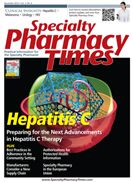Publication
Article
Specialty Pharmacy Times
Best Practices in Adherence in the Community Setting
Author(s):
Medication nonadherence is a growing issue for patients, clinicians, health care systems, and payers because of mounting evidence that it is prevalent and associated with adverse outcomes and higher costs of care. Here are some best practices to get people to take the medicines prescribed for them.
Medication nonadherence is a growing issue for patients, clinicians, health care systems, and payers because of mounting evidence that it is prevalent and associated with adverse outcomes and higher costs of care. Here are some best practices to get people to take the medicines prescribed for them.
Medication adherence usually refers to whether patients take their medications as prescribed—for example, twice daily—as well as how they continue to take a prescribed medication. Medication nonadherence is a growing issue for patients, clinicians, health care systems, and payers because of mounting evidence that it is prevalent and associated with adverse outcomes and higher costs of care.
The measurement of patient medication adherence and use of interventions to improve adherence are increasing in routine clinical practice across the pharmacy community. The cost of nonadherence is trending into the billions of dollars in lost productivity. Nonadherence is also being reported at a rate of approximately 50% in some disease states, such as depression, and is even higher in other disease states, such as HIV. The goal of this article is to address different methods of practicing adherence and best practices used by some pharmacies around the country in sustaining a high level of adherence for their patients on long-term therapy.
Refill Adherence
In an effort to ensure that patients do not run out of medications, Central Drugs of Portland, Oregon, for example, implements the following system to promote refill adherence. The staff at Central Drugs follows strict manual protocols with respect to the management of refills for patients. They have 2 individuals who are devoted to communicating with patients and their providers with respect to their therapies and refill needs. Monthly refill reminder calls are made by pharmacists on the 24th day after a dispense is made. Pharmacists re-call patients every 72 hours when no response is received.
When the patient, pharmacy, and physician are in agreement on such arrangements, pharmacy staff contact providers when adherence issues are noted and provide adherence reporting to providers to use during their appointments with patients. All patients who have started antiretroviral therapy receive a follow-up call on the second day after initiation of new therapy to answer any additional questions and/or to assess for any side effects. The pharmacy staff works with the team at the clinic to acquire each patient’s clinical laboratory results and inputs this information into the pharmacy management system.
The prescribing physician is contacted at least 1 week in advance of the patient needing refill authorization to ensure adequate time to authorize the refill as well as to discuss potential changes to therapies. For individuals who choose such services, Central Drugs can text message and/or call them to let them know when their prescriptions are ready to be picked up, as well as to establish a time to deliver to patients who opt for this service. In addition to extending efforts to ensure that individuals do not run out of refills, Central Drugs offers solutions to help make the daily management of these therapies as easy a possible. For example, Central Drugs provides a “salad pack” style of blister packaging solution at no charge, where pharmacy staff package a patient’s medications into morning, noon, evening, and bedtime dosing. All the patient needs to do is punch out the appropriate time of day and all of the medications a patient needs fall into his/her hand. Such packaging solutions help to ensure that patients do not inadvertently miss medications. In the event they do, both the provider and the patient can see what time of day the patient is experiencing adherence challenges.
Individual Drug Therapy
Successful pharmacotherapy is specific for every patient. It includes individual drug therapy decisions, reaching an agreement between the patient and the health care provider on the therapeutic outcome and how it may be achieved, and critical patient monitoring activities. In oncology, for example, for each individual patient’s drug treatment, the clinical pharmacists at Elwyn Specialty Care in Glen Mills, Pennsylvania, develop a care plan together with each patient/ prescriber. Patients can then contribute to successful outcomes by taking part of the responsibility for their own care and feeling empowered to effect a positive outcome on their health.
In the area of adherence and compliance, Elwyn Specialty Care focuses on simplifying the dosage regimen and other strategies, including combinations of more thorough patient instructions and counseling, assessments of drug interactions and adverse reactions, refill reminders, supervised selfmonitoring, medication compliance packaging, triage with other health care providers, reduction of cost barriers, and constant and regular follow-up with each patient. The common thread to these is the fact that more frequent interaction with patients improves patient outcomes.
Final Thought
In conclusion, researchers have routinely found that improved medication adherence—getting people to take medicine prescribed for them—is associated with greatly reduced total health care use and costs. The examples given for Central Drugs and Elwyn Specialty Care, both members of the CSPN network, show that specific intervention practices improve medication adherence for patients with complex disease states, such as oncology and HIV.
We must also realize that these practices lead to increased pharmacy costs; however, they should also produce substantial overall cost savings as a result of reductions in hospitalization and emergency department use. Our findings indicate that programs to improve medication adherence are worth consideration by insurers, government payers, and patients, as long as intervention costs do not exceed the estimated health care cost savings.
About the Author
Nicodemo “Nick” Calla, RPh, JD, is vice president of industry relations, Community Specialty Pharmacy Network. He is an editorial board member of Specialty Pharmacy Times.







